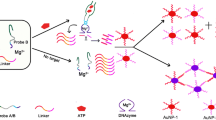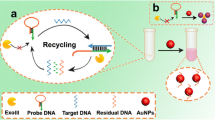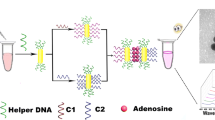Abstract
A rapid, highly sensitive and selective colorimetric assay is presented for visually detecting L-histidine. It is based on L-histidine-triggered self-cleavage of DNA duplex-induced gold nanoparticle (AuNP) aggregation. The citrate-capped AuNPs easily aggregate in a high concentration of salt environment. However, in the presence of L-histidine aptamers (DNA1 and DNA2), the partial strands of DNA1 and DNA2 hybridize to form a DNA duplex with a swing structure. The swing-like DNA duplexes are adsorbed on the surface of AuNPs to improve the stability of AuNPs, and the AuNPs also are better dispersed in high-salt media. When L-histidine is added to the solutions, it catalyzes the self-cleavage of DNA1 to form many single-stranded DNA (ssDNA) fragments. These ssDNA segments are adsorbed on the AuNPs and weaken the stability of AuNPs. Hence, the AuNPs aggregate in high-salt environment, and this results in a red-to-blue color change. Under the optimized conditions, L-histidine can be determined with a limit of detection of 3.6 nM. In addition, the sensor was successfully applied to the determination of L-histidine in spiked serum samples.

Schematic of a rapid and homogeneous colorimetric L-histidine assay. It combines L-histidine-triggered self-cleavage of the swing-like DNA duplexes and self-cleavage of DNA-induced AuNP aggregation.






Similar content being viewed by others
References
Li X, Ma H, Nie L, Sun M, Xiong S (2004) A novel fluorescent probe for selective labeling of histidine. Anal Chim Acta 515:255–260
Guo Nan C, Xiao Ping W, Jian Ping D, Hong Qing C (1999) A study on electrochemistry of histidine and its metabolites based on the diazo coupling reaction. Talanta 49:319–330
Watanabe M, Suliman ME, Qureshi AR, Garcia-Lopez E, Barany P, Heimburger O, Stenvinkel P, Lindholm B (2008) Consequences of low plasma histidine in chronic kidney disease patients: associations with inflammation, oxidative stress, and mortality. Am J Clin Nutr 87:1860–1866
Rao KVR, Reddy PVB, Tong X, Norenberg MD (2010) Brain edema in acute liver failure: inhibition by L-histidine. Am J Pathol 176:1400–1408
Gerber DA (1975) Low free serum histidine concentration in rheumatoid arthritis. A measure of disease activity. J Clin Invest 55:1164–1173
Jones AL, Hulett MD, Parish CR (2005) Histidine-rich glycoprotein: a noveladaptor protein in plasma that modulates the immune, vascular and coagulation systems. Cell Biol 83:106–118
Seshadri S, Beiser A, Selhub J, Jacques PF, Rosenberg IH, D’Agostino RB, Wilson PW, Wolf PA (2002) Plasma homocysteine as a risk factor for dementia and alzheimer’s disease. N Engl J Med 346:476–483
Verri C, Roz L, Conte D, Liloglou T, Livio A, Vesin A, Fabbri A, Andriani F, Brambilla C, Tavecchio L, Calarco G, Calabro E, Mancini A, Tosi D, Bossi P, Field JK, Braimbilla E, Sozzi G (2009) Fragile histidine triad gene inactivation in lung cancer: the European early lung cancer project. Am J Respir Crit Care Med 179:396–401
Wadud S, Or-Rashi MM, Onodera R (2002) Method for determination of histidine in tissues by isocratic high-performance liquid chromatography and its application to the measurement of histidinol dehydrogenase activity in six cattle organs. J Chromatogr B 767:369–374
Zhou L, Yan N, Zhang H, Zhou X, Pu Q, Hu Z (2010) Microwave-accelerated derivatization for capillary electrophoresis with laser-induced fluorescence detection: a case study for determination of histidine 1-and 3-methylhistidine in human urine. Talanta 82:72–77
Meng J, Zhang W, Cao CX, Fan LY, Wu J, Wang QL (2010) Moving affinity boundary electrophoresis and its selective isolation of histidine in urine. Analyst 135:1592–1599
Natsume T, Nakayama H, Jansson Ö, Isobe T, Takio K, Mikoshiba K (2000) Combination of biomolecular interaction analysis and mass spectrometric amino acid sequencing. Anal Chem 72:4193–4198
Chen Z, He Q, Zhao M, Lin C, Luo F, Lin Z, Chen G (2017) A fluorometric histidine biosensor based on the use of a quencher-labeled cu(II)-dependent DNAzyme. Microchim Acta 184:4015–4020
Li LD, Chen ZB, Zhao HT, Guo L (2011) Electrochemical real-time detection of L-histidine via self-cleavage of DNAzymes. Biosens Bioelectron 26:2781–2785
Chen Z, Nai J, Ma H, Li Z (2014) Nickel hydroxide nanocrystals-modified glassy carbon electrodes for sensitive L-histidine detection. Electrochim Acta 116:258–262
Liu QY, Yang YT, Li H, Zhu RR, Shao Q, Yang SG, Xu JJ (2015) NiO nanoparticles modified with 5,10,15,20-tetrakis(4-carboxyl pheyl)-porphyrin: promising peroxidase mimetics for H2O2 and glucose detection. Biosens Bioelectron 64:147–153
Zhang LY, Chen MX, Jiang YL, Chen MM, Ding YN, Liu QY (2017) A facile preparation of montmorillonite-supported copper sulfide nanocomposites and their application in the detection of H2O2. Sensors Actuators B Chem 239:28–35
Sun LF, Ding YY, Jiang YL, Liu QY (2017) Montmorillonite-loaded ceria nanocomposites with superior peroxidase-like activity for rapid colorimetric detection of H2O2. Sensors Actuators B Chem 239:848–856
Ding Y, Yang B, Liu H, Liu Z, Zhang X, Zheng X, Liu Q (2018) FePt-au ternary metallic nanoparticles with the enhanced peroxidase-like activity for ultrafast colorimetric detection of H2O2. Sensors Actuators B Chem 259:775–783
Jiang W, Wang Z, Beier R, Jiang H, Wu Y, Shen J (2013) Simultaneous determination of 13 fluoroquinolone and 22 sulfonamide residues in milk by a dual-colorimetric enzyme-linked immunosorbent assay. Anal Chem 85:1995–1999
Chen M, Yang B, Zhu J, Liu H, Zhang X, Zheng X, Liu Q (2018) FePt nanoparticles-decorated graphene oxide nanosheets as enhanced peroxidase mimics for sensitive response to H2O2. Mater Sci Eng C 90:610–620
Marzo A, Pons J, Blake D, Merkoci A (2013) All-integrated and highly sensitive paper based device with sample treatment platform for Cd2+ immunodetection in drinking/tap waters. Anal Chem 85:3532–3538
Qu W, Liu Y, Liu D, Wang Z, Jiang X (2011) Copper-mediated amplification allows readout of immunoassays by the naked eye. Angew Chem Int Ed 50:3442–3445
Huang P, Li J, Song J, Gao N, Wu F (2016) Silver nanoparticles modified with sulfanilic acid for one-step colorimetric and visual determination of histidine in serum. Microchim Acta 183:1865–1872
Roth A, Breaker RR (1998) An amino acid as a cofactor for a catalytic polynucleotide. Proc Natl Acad Sci U S A 95:6027–6031
Li ZJ, Zhao J, Wang ZY, Dai ZH (2018) Nickel-mediated allosteric manipulation of G-quadruplex DNAzyme for highly selective detection of histidine. Anal Chim Acta 1008:90–95
Rawat KA, Kailasa SK (2016) 4-amino nicotinic acid mediated synthesis of gold nanoparticles forvisual detection of arginine, histidine, methionine and tryptophan. Sensors Actuators B Chem 222:780–789
Liu Y, Ding D, Zhen YL, Guo R (2017) Amino acid-mediated ‘turn-off/turn-on’ nanozyme activity of gold nanoclusters for sensitive and selective detection of copper ions and histidine. Biosens Bioelectron 92:140–146
Gu P, Zhang GH, Deng ZY, Tang ZW, Zhang HF, Khusbu FY, Wu KF, Chen MJ, Ma CB (2018) A novel label-free colorimetric detection of L-histidine using Cu2+-modulated G-quadruplex-based DNAzymes. Spectrochim Acta A 203:195–200
Wu CT, Fan DQ, Zhou CY, Liu YQ, Wang EK (2016) Colorimetric strategy for highly sensitive and selective simultaneous detection of histidine and cysteine based on G-quadruplex-cu(II) metalloenzyme. Anal Chem 88:2899–2903
Gu ZF, Cao ZJ (2018) Molecular switch-modulated fluorescent copper nanoclusters for selective and sensitive detection of histidine and cysteine. Anal Bioanal Chem 410:4991–4999
Zhang ZZ, Wang L, Li GP, Ye BX (2017) Lanthanide coordination polymer nanoparticles as a turn-on fluorescence sensing platform for simultaneous detection of histidine and cysteine. Analyst 142:1821–1826
Zhu XH, Zhao TB, Nie Z, Miao Z, Liu Y, Yao SZ (2016) Nitrogen-doped carbon nanoparticle modulated turn-on fluorescent probes for histidine detection and its imaging in living cells. Nanoscale 8:2205–2211
Wang ZY, Fan ZF (2018) Cu2+ modulated nitrogen-doped grapheme quantum dots as a turn-off/on fluorescence sensor for the selective detection of histidine in biological fluid. Spectrochim Acta A 189:195–201
Acknowledgements
This study was supported by Scientific Research Project of Beijing Educational Committee (Grant No. KM201710028009), Youth Innovative Research Team of Capital Normal University, and Capacity Building for Sci-Tech Innovation - Fundamental Scientific Research Funds (025185305000/195).
Author information
Authors and Affiliations
Corresponding authors
Ethics declarations
The author(s) declare that they have no competing interests.
Additional information
A colorimetric assay for detecting L-histidine based on target L-histidine-triggered self-cleavage of DNA duplex-induced AuNP aggregation.
Electronic supplementary material
ESM 1
(DOCX 131 kb)
Rights and permissions
About this article
Cite this article
Jiao, Y., Liu, Q., Qiang, H. et al. Colorimetric detection of L-histidine based on the target-triggered self-cleavage of swing-structured DNA duplex-induced aggregation of gold nanoparticles. Microchim Acta 185, 452 (2018). https://doi.org/10.1007/s00604-018-2987-z
Received:
Accepted:
Published:
DOI: https://doi.org/10.1007/s00604-018-2987-z




